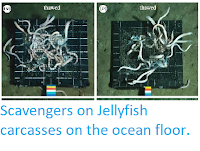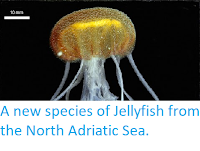A warning has been issued to tourists visiting Ko Mak Island in Trat Province, Thailand, after several bathers were stung by Box Jellyfish, Cubozoa, on Thursday 22 and Friday 23 March 2018. A number of safe areas for bathing have been set up, which are protected by fishing nets that should prevent the Jellyfish from entering, but otherwise people are being recommended to avoid the water. Blooms of Box Jellyfish are a common occurrence in the Gulf of Thailand at this time of year, and present a regular threat to bathers, with eight recorded deaths in Thailand's coastal provinces since 1999, and hundreds of people being stung each year. People stung by a Box Jellyfish are recommended to leave the water immediately and treat the sting with vinegar, which should be poured on but not rubbed, before seeking medical attention.
A Box Jellyfish in the water near a bather in Thailand. Thai Box Jellyfish.
Most Box Jellyfish encountered in Thai waters belong to the species Chironex flecker, sometimes known as the Sea Wasp, which is endemic to shallow coastal waters and which has a particularly potent sting, with an adult of the species producing enough venom to kill around adult Humans, which makes them a common cause of fatalities from Southeast Asia to Australia. Box Jellyfish are particularly dangerous as they do not simply drift passively as other Jellyfish do, but posses well developed eyes, muscular and nervous systems, allowing them to actively hunt small prey, and sometimes (probably inadvertently) attack Humans.
Injuries caused by a Box Jellyfish sting. Thai Box Jellyfish.
See also...
Follow Sciency Thoughts on Facebook.








